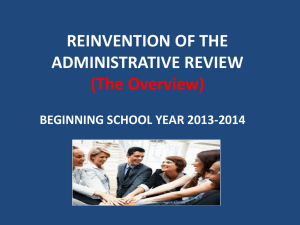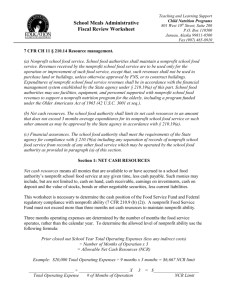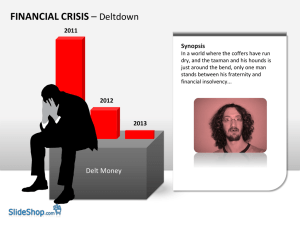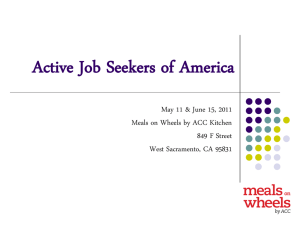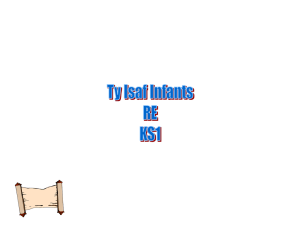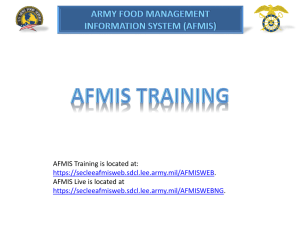School Food Service Finance Issues
advertisement
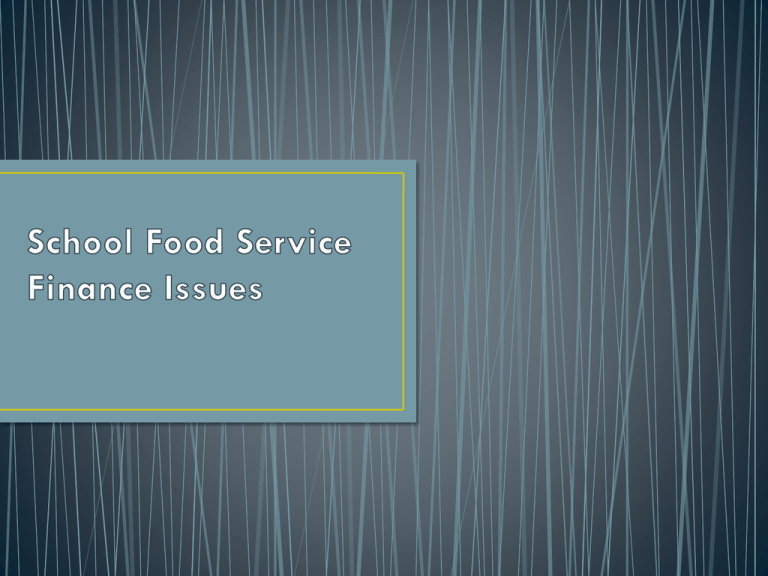
Meal Equivalents – the conversion of operational data for all food sales into a standard unit of measurement to gauge the effectiveness and efficiency of a school foodservice program. By converting all food sales to meal equivalents, the SFA can determine: •per meal cost •productivity ratios such as meals per labor hour Cost of Food Used – Important information that is used to determine whether costs are within guidelines and funds that are available to cover costs. Cost of food used must be calculated before the school foodservice administrator can determine meal costs. A physical inventory must be taken consistently and on a regular basis (a minimum of a monthly inventory is recommended) to obtain current and accurate results. Cost of Food Used = Beginning Food Inventory $8,000 + Food Purchases $25,000 = Total Food Available $33,000 - Ending Purchased Food Inventory $7,000 = Cost of Food Used $26,000 Streamlined Food Inventory – Integration of commodity and purchased foods. When calculating the cost of food used, the value of USDA-donated commodities must be considered. Inventories of donated foods are no longer required to be separate from inventories of other foods. Commodities are now tracked with purchased foods in the food inventory with the commodity value entered as purchased price. Monthly physical inventory accounts for both the purchased and commodity food. Per Meal Costs Meal Cost is determined by dividing total expenditures for a given reporting period by total meal equivalents during the same period. Expenditures include all costs to the school foodservice program, including food costs, labor costs, supply costs, and all other costs. Meal Cost = Total Expenditures Lunches and Meal Equivalents Pre-Costing of Menus Pre-costing of menus can be completed in the inTEAM Menu Compliance Tool that KDE provided to every NSLP sponsor in the fall of 2012. This tool assists the director in pre-costing (food cost) of menus and helps establish an average meal cost. https://www.cncentral.net/MenuInfo/MenuInfo.aspx?enc=ZguS/GWatRcOlbjVos3reB x C1b2iTXMdkpvzhVBFpM= Meals and Non-reimbursable Food Items Reimbursable Pricing Meal Pricing Paid Lunch Equity Tool – Required by Healthy HungerFree Kids Act, 2010 Requires SFAs participating in the National School Lunch Program to ensure sufficient funds are provided to the nonprofit school food service account for lunches served to students not eligible for free or reduced price meals, to prevent the free and reduced reimbursement subsidizing paid lunch meals. There are two ways to meet this requirement: either through the prices charged for “paid” lunches or through other non-Federal sources provided to the nonprofit SFA account. The Paid Lunch Equity tool is completed annually and submitted with the SFA’s application and agreement. Pricing of Non-reimbursable Food Items Non-program Food Revenue Tool – Required by Healthy Hunger-Free Kids Act. Objective – Ensure nonprogram activities are not subsidized by program revenues. National School Lunch Program School Breakfast Program Adult Meals AfterSchool Snacks Special Milk Program Catered Meals A la Carte Sales Fresh Fruit and Vegetable Program Obtain an average reimbursable meal cost for Breakfast, Lunch, ASCP Multiply the average meal cost by the number of meals served in a month Equals one month’s food costs for reimbursable meals Subtract calculated cost for reimbursable meals from total food cost Equals nonprogram food cost Gather the following information: • Food costs of reimbursable meals (Munis code 0630, CACFP 0630C) • Food costs of non-program foods (Munis code 0630N) • Revenue from non-program foods (Munis code 1620) • Total revenue • 1. Each sponsor will need to enter the opening fund balance (not cash balance) • 2. Revenues: a. Program revenues are those collected from reimbursable meals. (N/A for CEP schools) b. State matching reimbursement is sent once a year (usually in April) c. Federal reimbursement is received monthly-only include reimbursement received for NSLP breakfast, lunch, after school snacks and FFVP. • d. Non-program revenue is any revenue received other than federal reimbursement-should include SFSP and CACFP at risk suppers, a la carte, adult meals, etc. • e. Total revenues are reported from a,b,c,d • f and g are automatically calculated by CNIPS • Program revenues are revenues collected for reimbursable breakfasts, lunches or snacks • Non-program revenues are revenues from any other source; for example, adult meals, a la carte sales, catering or special functions 3. Expenditures for Reporting Period: a. Program Food Expenditures are those used to produce reimbursable meals. (see guidance for calculating) b. Non program expenditures are those used for anything other than reimbursable meals or snacks. c. Salaries are direct labor paid from food service d. Employee benefits are those paid by the employer (school district-does not include on behalf payments) • e Purchased services are those done by a company, such as pest control • f. Equipment purchase is any equipment over $5,000 (non expendable) • g. Supplies/miscellaneous are anything under $5,000-should be expendable. • h. Indirect costs (if applicable)-complete only if indirect cost is paid to the general fund • i. Total Fund Expenditures are calculated by adding a through h. • Program Expenditures (costs) are those used for reimbursable meals. • Non-Program Expenditures (costs) are all other foods sold. Examples would be adult meals, a la carte sales, catering, etc. • The proportion of total revenue from the sale of non-program foods to the total revenue of the school food service account should be equal to or greater than the proportion of total food costs associated with obtaining non-program foods to the total costs from the account. • 4. Closing Fund Balance=Item 2e plus Item 1-Item 3 • 5. Gain or loss =Item 2e-Item 3 (will be positive or negative • 6. Three Month Average Operating Cost=Item 3 I divided by 4 • 7. Cash Balance is account 6101 on balance sheet (actual cash in bank) • Excess balance=Item 7-Item 6. If item 7 is more than item 6 then there is an excess balance in food service account and you will be contacted to tell us how you intend to lower the balance • 9. Enter the indirect cost rate provided by KDE or if a Private non profit or RCCI use a rate of 10% • 10 Indirect cost for food service operation=Item 3(c+d) times indirect cost rate Program Regulations for Procurement: • National School Lunch Program: 7 CFR 210.21 • School Breakfast Program: 7 CFR 220.16 • Special Milk Program: 7 CFR Part 215 • Food Distribution: 7 CFR Part 250 Uniform Administrative Requirements for Procurement: • State/local governments: 7 CFR 3016 • Non-profits: 7 CFR 3019 Government Wide Federal Regulations OMB Circulars • A-87 – Allowable costs • A-102, A-110 • A-122 State and Local Laws, Regulations, and Policies that are not in conflict with Federal Requirements. Public School Food Authorities Public School Food Authorities (SFAs) may use their own procurement procedures which reflect applicable state and local laws and regulations, provided that the procurements conform to applicable federal laws and standards identified in 7 CFR Part 3016.36 and Part 3016.60. SFAs must compare their state and local requirements against the federal requirements and follow the most restrictive! Renovating a School Kitchen • 2 CFR Part 225, Appendix B, section 25, Maintenance, operations and repairs, identifies costs of normal repairs and alterations as allowable so long as they: (1) keep property in an efficient operating condition; (2) do not add to the permanent value of the property or appreciably prolong its intended life; and (3) are not otherwise included in rental costs or other charges for space. Based on these principles, FNS has allowed limited renovations within the inside perimeter of a kitchen/cafeteria space with the required prior SA approval. • Renovating a School Kitchen • For example, renovating a kitchen by cutting away a portion of the wall to allow room for a walk‐in refrigerator and related electrical wiring would be an allowable expense if the renovation is necessary to accommodate increased participation of students in the School Meal Programs. However, it would be an unallowable expense if renovation of the kitchen was purely an aesthetic matter. • Finally, the SFA cannot charge normal maintenance costs directly to the nonprofit school food service account if such costs are included in the school district’s indirect cost pool. • Building a School Kitchen SMPs regulations in 7 CFR Parts 210.14 and 220.7(e)(1) require that revenues received by the nonprofit school food service are to be used only for the operation or improvement of such food service, except that, such revenue shall not be used to purchase land or buildings, or to construct buildings, unless otherwise approved by the FNS. Historically, FNS has not approved the cost of building purchases because program funds are made available to help support the costs of nutritional benefits for children in school settings and not to construct school related facilities. The goal is to ensure that an SFA maintains the necessary funding to operate the program as required by the SMPs’ authorizing legislation and regulations, and that the nonprofit school food service account is not used to cover major expenses that should be borne by the school district’s general funds (i.e., capital infrastructure costs). Building a School Kitchen The costs of building a kitchen are analogous to the costs of constructing school buildings, which historically have been borne by the school district with general or capital improvement funds. Similarly, such capital infrastructure costs should be borne by the school district just as the school building and its contents should be. Equipment Purchases If food service equipment is to be purchased with Food Service Cash, this equipment must be bid separately from the bidding of the rest of the project using wage rates as outlined under provisions of the Davis-Bacon Act and bidding provisions outlined in the Office of Management and Budget Circular A87 and in 7 CFR 3016 for the expenditure of these monies. Equipment Purchases Per OMB A-87: • This can be undertaken by bidding Food Service Equipment as an “Alternate” and clearly outlining in the contract documents the terms under which this equipment is to be bid. • Cost contracts and cooperative purchase agreements can only be used if they were procured using the Federal Guidelines noted herein. • Please note that State and Local Equipment Cost Contracts are NOT valid unless they have been procured through the federal provisions noted above and these bid must be undertaken for EACH project. • When submitting the BG1 to Facilities Management at KDE for approval, it must state that Fund 51 will pay for the equipment if allocated as such. • Requirement 7 CFR Part 3016 – 7 CFR Part 3019 – (Public) (Non-Profit) Competition in all procurements 3016.36(c) 3019.43 Award only to responsible & responsive vendors 3016.36 (b) (8) 3019.44(d) Written selection procedures 3016.36(c)(3) 3019.44(a)(3) Code of Conduct Recordkeeping Contract Administration System 3016.36(b)(3) 3016.36(b)(9) 3016.36(b)(2) 3019.42 3019.46 3019.41 Prohibition on geographic 3016.60 and preference, unless specifically 3016.36(c)(2) permitted by Federal law (such as 2008 Farm Bill) Not addressed 7 CFR Part 210 and 220 ALL funds received by the non profit school food account must be used to obtain food and other goods and services for use in the Child Nutrition Program (CNP). • Purchase food, supplies, equipment required for meal prep and service; • Purchase prepared meals from vendors; • Pay Food Service Management Company to operate their food service; • Pay for labor and operational costs; • Pay indirect costs • Use nonrestricted rate or a lesser rate • Apply the rate to salaries and benefits (excluding on-behalf payments) • Cannot treat something as a direct cost if it is also included in the indirect cost pool Indirect Cost Pool • If a cost is considered a direct cost to one federal program, it must be treated as a direct cost to ALL federal programs • Example: garbage removal • Example: maintenance personnel • Recommendation: make indirect cost entry monthly Questions? http://www.fns.usda.gov www.nfsmi.org Sue Bartenfield Branch Manager School & Community Nutrition Kentucky Dept. of Education sue.bartenfield@education.ky.gov Valerie Crouch, SNS Administrative Section Supervisor Programmatic Delivery Section School and Community Nutrition Kentucky Dept. of Education valerie.crouch@education.ky.gov Questions? Susan Barkley Assistant Director Division of District Support Kentucky Dept. of Education susan.barkley@education.ky.gov
